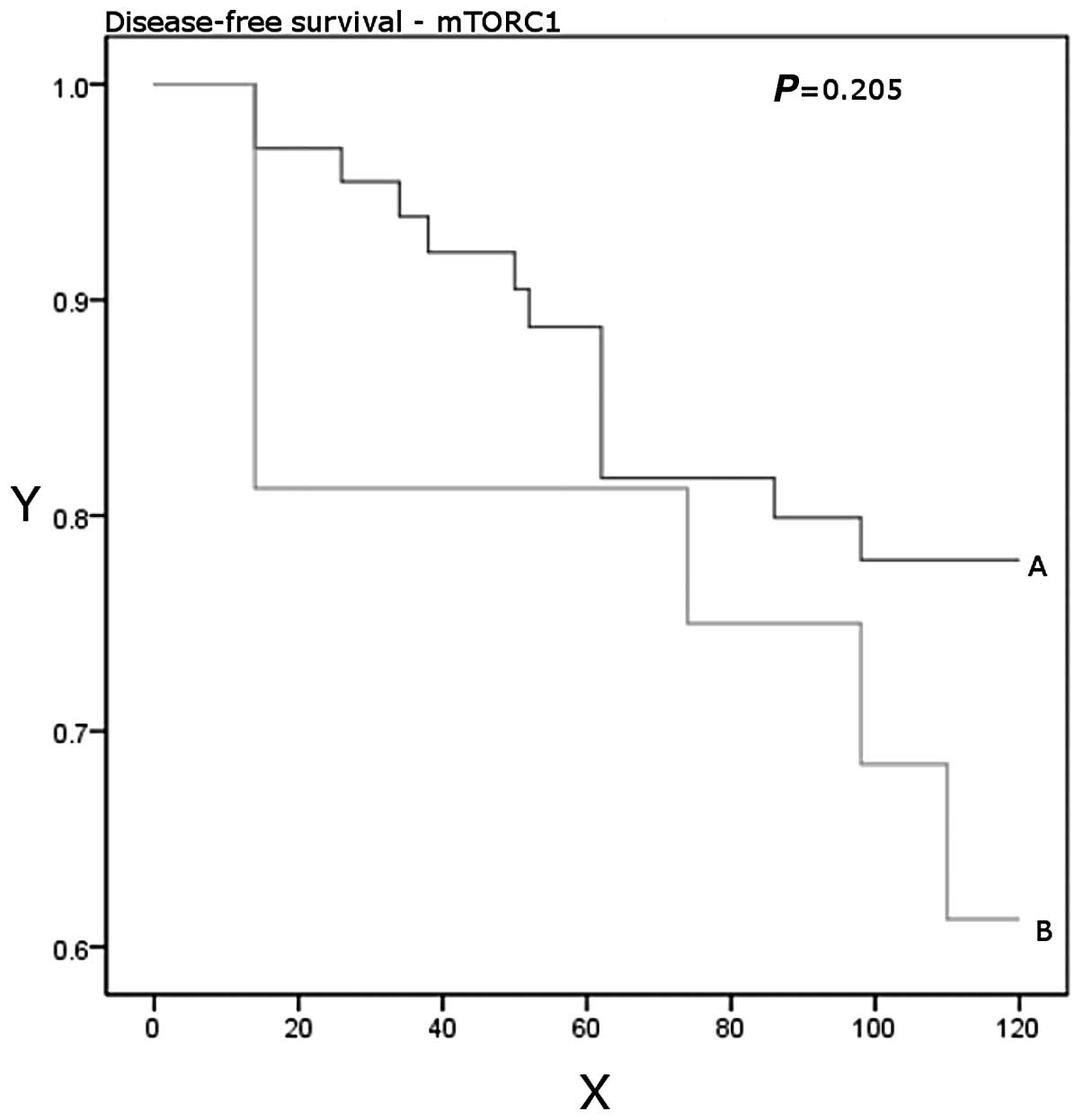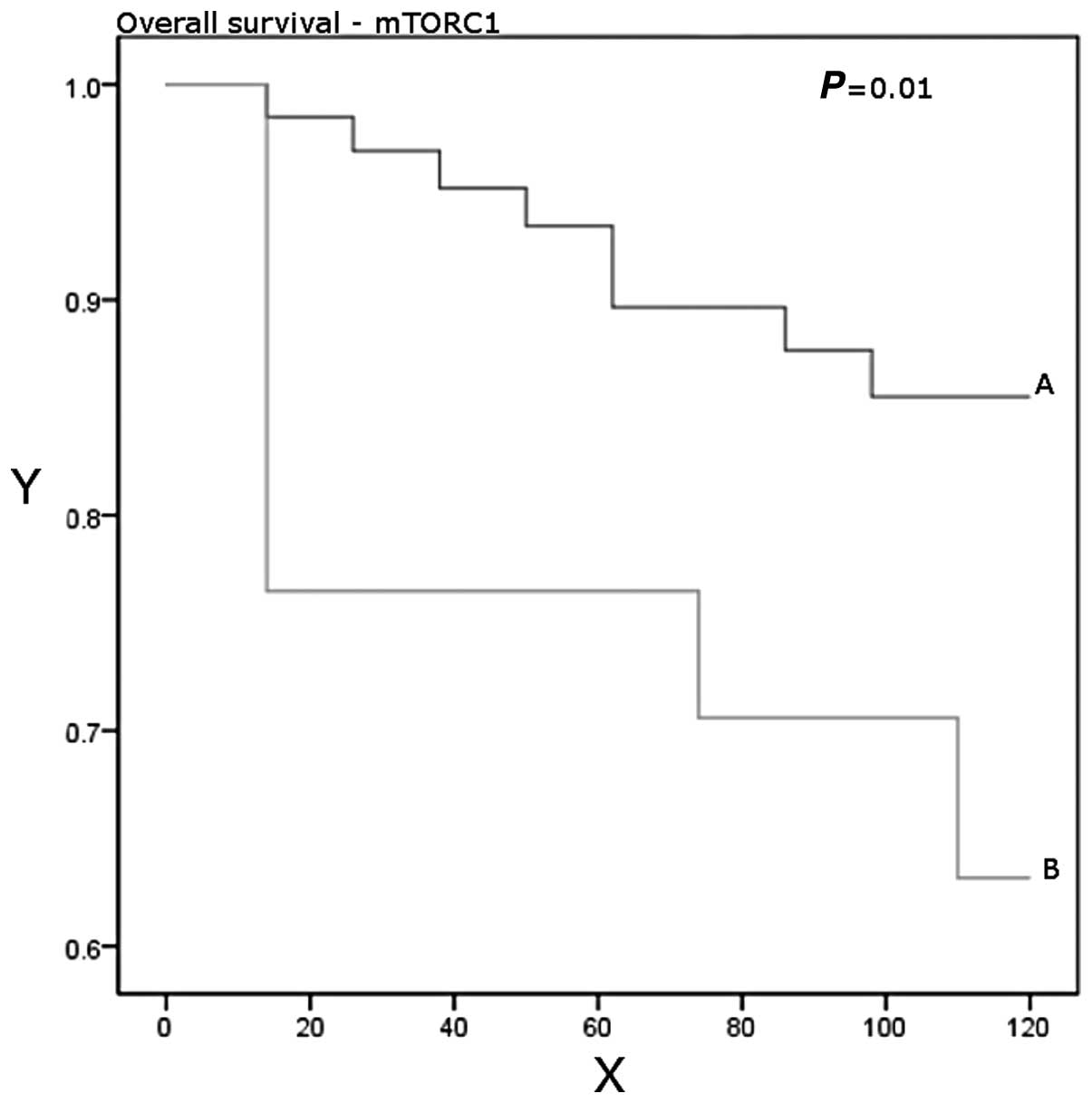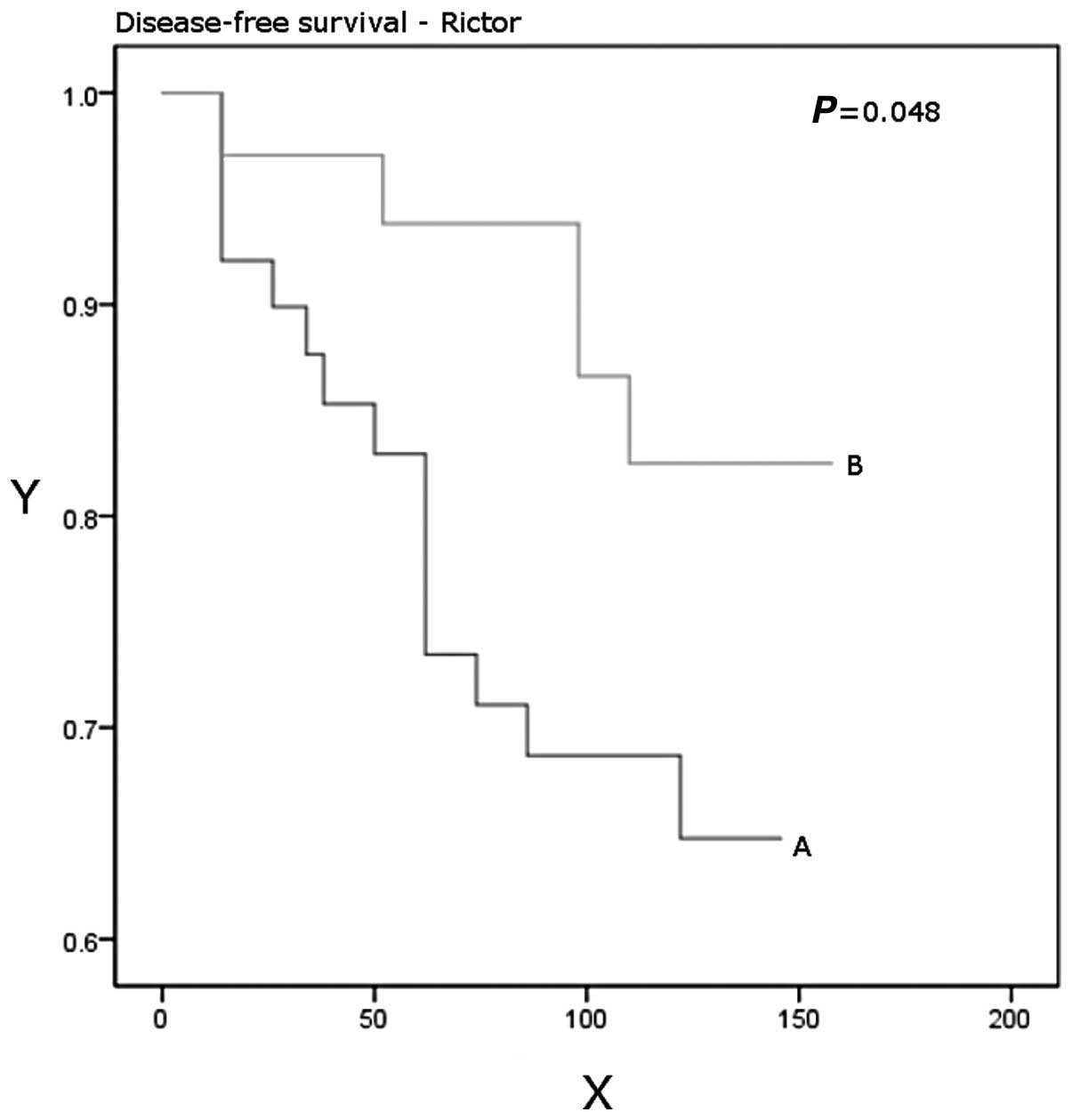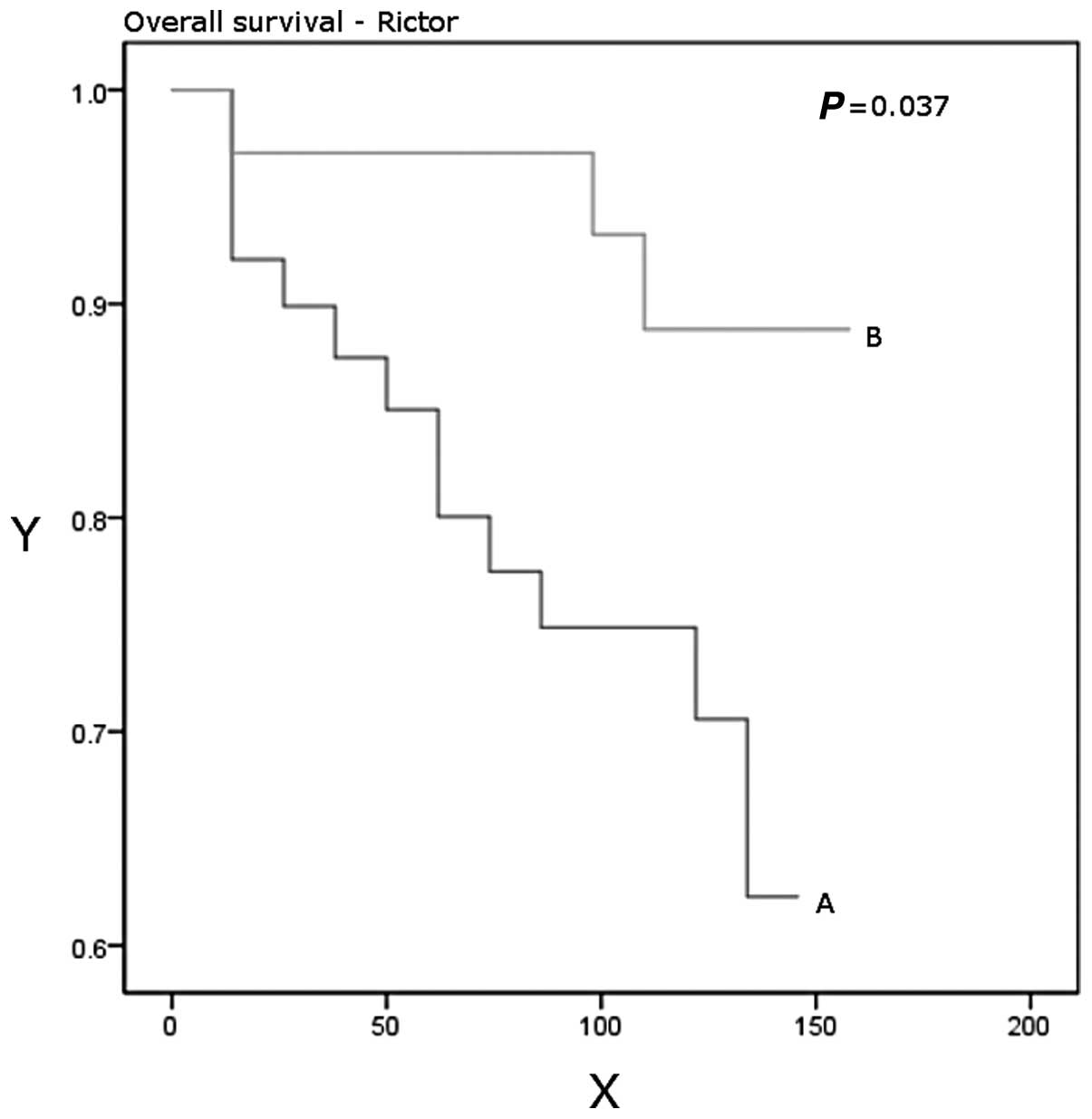Prognostic and therapeutic implications of mTORC1 and Rictor expression in human breast cancer
- Authors:
- Published online on: March 13, 2013 https://doi.org/10.3892/or.2013.2346
- Pages: 1969-1974
Abstract
Introduction
The mammalian target of rapamycin (mTOR) plays a key role in the regulation of cellular metabolism, growth and proliferation. It was found to mediate the anti-proliferative activities of rapamycin and its analogues (rapalogues). It forms two multi-protein complexes known as complex 1 (mTORC1) and 2 (mTORC2). Raptor and Rictor are the core proteins for mTORC1 and mTORC2, respectively, known to be essential for the integrity of their respective complexes (1,2). Rheb (Ras homologue enriched in brain) is a key activator of mTORC1. There is a growing body of evidence that mTORC1 is upregulated in many types of cancers and plays a role in carcinogenesis (3).
Rapalogues have been clinically proven in the case of renal cell carcinoma (4,5). However, this success is yet to be replicated in the case of other cancers. A greater understanding of the role of mTOR in various types of cancers is needed to determine therapeutic strategies. To this end, studies have been carried out to identify potential markers of rapamycin sensitivity, as well as additional therapeutic agents (6,7).
The aim of the study was to investigate the mRNA expression of mTORC1, Rictor, Raptor and Rheb in human breast cancer and examine the relationship between their expression and clinicopathological parameters. Furthermore, the correlation between mTORC1 and human telomerase reverse transcriptase (hTERT; the catalytic subunit of telomerase) was investigated.
Materials and methods
Samples
Tissue samples were collected after informed consent with ethical approval as per contemporaneous institutional guidelines. Immediately after surgical excision, a tumour sample was taken from the tumour area, while another was taken from the associated non-cancerous tissue (ANCT) within 2 cm of the tumour, without affecting the assessment of tumour margins. Breast cancer tissues (n=150) and normal background tissues (n=31) were collected and stored at −80°C in liquid nitrogen until the commencement of this study.
All the patients were treated according to local guidelines, following discussions in multidisciplinary meetings. Patients undergoing breast-conserving surgery also underwent radiotherapy. Hormone-sensitive patients received tamoxifen. Hormone-insensitive cases, high-grade cancer, and node-positive cases were treated with adjuvant therapy. Clinicopathological data (Table I) were collected from the patient charts and collated in an encrypted database.
RNA extraction kits and reverse transcription kits were obtained from AbGene, Ltd. (Surrey, UK). PCR primers were designed using Beacon Designer (Premier Biosoft International, Ltd., Palo Alto, CA, USA) and synthesized by Invitrogen, Ltd. (Paisley, UK). Custom made Hot Start Master Mix for quantitative PCR was from AbGene (8).
Tissue processing, RNA extraction and cDNA synthesis
Approximately 10 mg of cancerous tissue was homogenised. A larger amount of ANCT (20–50 mg) was used as its high fat content made it difficult to obtain sufficient RNA for analysis. The concentration of RNA was determined using a UV spectrophotometer (Wolf Laboratories, York, UK) to ensure adequate amounts of RNA for analysis. Reverse transcription was carried out using a reverse transcription kit (AbGene) with an anchored oligo(dT) primer using 1 mg of total RNA in a 96-well plate to produce cDNA. The quality of cDNA was verified using β-actin primers (5′-ATGATATCGCCGCGCTCGTC-3′ and 5′-CGCTCGGTGAGGATCTTCA-3′) (8).
Quantitative analysis
Transcripts of the cDNA library were determined using real-time quantitative polymerase chain reaction (qPCR) based on Amplifluor technology. The PCR primers were designed using Beacon Designer software, but an additional sequence, known as the Z sequence (5′-ACTGAACCTGACCGTACA-3′), which is complementary to the universal Z probe (Intergen, Inc., Oxford, UK) was added to the primer. The primers used are detailed in Table II.
The reaction was carried out under the following conditions: 94°C for 12 min and 50 cycles of 94°C for 15 sec, 55°C for 40 sec and 72ºC for 20 sec. The levels of each transcript were generated from a standard plasmid which contained the specific DNA sequence that was simultaneously amplified within the samples. With every run of the PCR, a negative and positive control was employed, using a known cDNA sequence (8).
Statistical analysis
Analysis of the data was performed using the Minitab 12 statistical software package (Minitab, Ltd., Coventry, UK) using a custom-written macro (Stat06e.mtb). Medians were compared using the Mann-Whitney U-test, while the means were compared using the two-sample t-test. The transcript levels within the breast cancer specimens were compared to those of the ANCT and correlated with clinicopathological data collected over a 10-year follow-up period.
P-values <0.05 were considered significant, whereas P-values between 0.05 and 0.10 were considered marginally significant. Correlations between the expression levels of the molecules were studied using the Pearson product moment correlation test.
For purposes of the Kaplan-Meier survival analysis, the samples were divided arbitrarily into high and low transcription groups, with the value for the moderate prognostic group as defined by Nottingham prognostic index (NPI) serving as the dividing line. Survival analyses were performed using PSAW18 (SPSS, Inc., Chicago, IL, USA).
Results
Significantly higher mTORC1 mRNA transcript levels were found in the breast cancer specimens compared to the normal glandular tissue (P=0.0018). The expression of mTORC1 mRNA was demonstrated to increase with increasing NPI (from 53 for NPI1 to 219 for NPI3) and tumour grade, and this difference reached statistical significance when comparing grade 2 with grade 3 (37 vs. 159, P=0.047). mTORC1 expression was found to be higher in ductal tumours compared with non-ductal tumours (P=0.0014). The patients who developed recurrent disease or died from breast cancer had higher expression levels of mTORC1 than those who had been disease-free after a median follow-up period of 10 years (P=0.17). Higher expression levels were significantly associated with worse overall survival (P=0.01; Table III, Figs. 1 and 2).
The mTORC2 core protein Rictor mRNA expression showed an opposing trend to mTORC1 with higher levels being found in normal breast tissue, lower NPI stage (NPI1 vs. 2, P=0.03) and lower tumour grade (grade 1 vs. 3, P=0.01 and grade 2 vs. 3, P=0.03). Patients with higher Rictor expression had a significantly better disease-free (P=0.048) and overall (P=0.037) survival (Table IV, Figs. 3 and 4).
The mTORC1 core protein Raptor mRNA expression was higher in the breast cancer specimens, and was found to be directly associated with tumour grade (grade 1 vs. 3, P=0.027). Paradoxically, it was found to be inversely correlated with TNM staging (TNM1 vs. 4, P=0.0343; Table V). Rheb mRNA expression was directly associated with tumour grade (grade 1 vs. 3, P=0.0078; Table VI). The mTORC1 mRNA showed a highly significant positive correlation with that of hTERT (r=0.585, P<0.00001; Table VII).
Discussion
Rapamycin is macrolide produced by Streptomyces hygroscopius. It was initially identified in soil samples taken from the Easter Islands, also known as Rapa Nui (9). It was remarkable for its effect on metabolism and cell growth. During the early 1990s, the studies of the effects of rapamycin on yeasts led to the discovery of the targets of rapamycin (TOR1 and 2). The mammalian targets of rapamycin (mTOR) was described shortly thereafter (10).
Initially, it was found that mTOR formed a multi-protein complex, later termed mTOR complex 1 (mTORC1). Other components of mTORC1 are mammalian lethal with sec-13 protein 8 (mLST8, also known as GβL), regulatory-associated protein of mammalian target of rapamycin (Raptor) (11), DEP domain containing mTOR-interacting protein (DEPTOR), the Tti1/Tel2 complex, and proline-rich Akt substrate 40 kDa (PRAS40) (10). The activity of mTORC1 is inhibited by rapamycin and other rapamycin analogues (rapalogues). Rapamycin forms a complex with FKBP12, which interacts with mTOR subunit of mTORC1 (12).
mTORC1 has been shown to be affected by various stimuli, including but not limited to hypoxia, nutritional state, stress, growth factors and amino acids. The majority of these stimuli are mediated by a number of effectors, such as protein kinase B (PKB, also known as Akt), extracellular-signal-regulated kinase 1/2 (ERK1/2) and ribosomal S6 kinase (RSK1) (10). Typically, these enzymes phosphorylate the tuberous sclerosis complex 1 and 2 (TSC1/2, also known as hamartin and tuberin, respectively) (13). This inactivates TSC1/2, which when active suppresses the activity of Ras homolog enriched in brain (Rheb). In such conditions, Rheb activates mTORC1 (14). The canonical Wnt pathway interacts with Rheb, as does the insulin/PI3K/Akt pathway (15,16). Alternatively, several upstream components may interact directly with Rheb. This is true with regards to mitogen-activated protein kinase (MAPK), which mediates stimuli from p38 (17). PKB/Akt also to a certain extent, acts directly upon Rheb. In turn, mTORC1 regulates lipid metabolism, glycolysis, protein synthesis, cell proliferation and autophagy (10,18).
In addition, upstream and downstream components of the mTOR pathway have been implicated in carcinogenesis. This has marked mTOR as a potential therapeutic target in cancer treatment (19). Rapalogues have been clinically proven in the treatment of renal cell carcinoma. Their limited side-effect profile makes their particularly attractive (4,5). However, rapalogues have had limited success as single agents in the case of other types of cancers. Considerable efforts have been made to identify potential markers of rapamycin sensitivity (7,20).
A less well described complex 2 (mTORC2) was also later identified. Similar to mTORC1, it is composed of the mTOR, mLST8, DEPTOR and Tti1/Tel2 complex (10). In addition it also contains rapamycin-insensitive companion of mTOR (Rictor) (21), mammalian stress-activated map kinase-interacting protein 1 (mSin1), and protein observed with Rictor 1 and 2 (protor1/2) (3). mTORC2 is not sensitive to rapamycin. Our understanding of the role of mTORC2 in the wider pathway is still evolving. It has been found to have a role in the regulation of cell survival and the cytoskeleton through the stimulation of various kinases, including Akt/PKB. Through Akt/PKB, it is also thought to inhibit mTORC1 (22).
hTERT is one of the three components of the telomerase complex, the others being the RNA template (hTR), and the associated protein (TEP-1). This complex repairs the sequences on the ends of chromosomes, which are termed telomeres. This function prevents cell senescence, and could be related with cell immortality (23). Increased hTERT activity has been implicated in various neoplastic diseases, including breast carcinoma (24). In endometrial carcinoma, rapamycin has been demonstrated to reduce hTERT mRNA expression (25). On the other hand, in hepatocellular carcinoma, rapamycin has been found to exert a post-transcriptional inhibitory effect on hTERT activity. However, no effect was found on hTERT mRNA expression (26). Evidence for a regulatory role for mTOR on telomerase activity has been found in the case of adult T cell leukaemia (27). hTERT activity has been suggested as a surrogate for rapamycin anti-neoplastic activity in endometrial carcinoma (25). Our finding of a highly significant positive correlation between mTORC1 and hTERT lends further support to the hypothesis that mTORC1 is an important regulator of hTERT and telomerase.
Our study shows significant correlations between the expression of mTORC1 and parameters of advanced disease in mammary carcinogenesis, including tumour grade and NPI and an inverse relationship to overall survival. This reiterates the potential for a therapeutic role for mTORC1 inhibitors in human breast cancer. The correlation of mTORC1 expression with ductal carcinoma suggests that such therapeutic agents may be more effective in treating patients with invasive ductal carcinoma. Our findings also suggest that mTORC1 may exert its carcinogenic effect through the upregulation of hTERT.
Whilst Raptor’s association with worsening tumour grade is consistent with its role in mTORC1, its paradoxical relationship with TNM stage would require further study along with other components of mTORC1.
This is the first study to show an inverse relationship between the Rictor subunit of mTORC2, NPI and tumour grade, as well as demonstrate a significant direct correlation of Rictor expression with disease-free and overall survival. This is suggestive of a more extensive countervailing role of mTORC2 versus mTORC1 than previously postulated.
Acknowledgements
This study was funded by grants from the Breast Cancer Hope Foundation (London, UK).
References
|
Shiota C, Woo JT, Lindner J, Shelton KD and Magnuson MA: Multiallelic disruption of the rictor gene in mice reveals that mTOR complex 2 is essential for fetal growth and viability. Dev Cell. 11:583–589. 2006. View Article : Google Scholar : PubMed/NCBI | |
|
Wu WK, Lee CW, Cho CH, Chan FK, Yu J and Sung JJ: RNA interference targeting raptor inhibits proliferation of gastric cancer cells. Exp Cell Res. 317:1353–1358. 2011. View Article : Google Scholar : PubMed/NCBI | |
|
Guertin DA and Sabatini DM: Defining the role of mTOR in cancer. Cancer Cell. 12:9–22. 2007. View Article : Google Scholar | |
|
Hudes G, Carducci M, Tomczak P, et al: Temsirolimus, interferon alfa, or both for advanced renal-cell carcinoma. N Engl J Med. 356:2271–2281. 2007. View Article : Google Scholar | |
|
Houghton PJ: Everolimus. Clin Cancer Res. 16:1368–1372. 2010. View Article : Google Scholar : PubMed/NCBI | |
|
Shor B, Zhang WG, Toral-Barza L, et al: A new pharmacologic action of CCI-779 involves FKBP12-independent inhibition of mTOR kinase activity and profound repression of global protein synthesis. Cancer Res. 68:2934–2943. 2008. View Article : Google Scholar : PubMed/NCBI | |
|
Noh WC, Mondesire WH, Peng J, et al: Determinants of rapamycin sensitivity in breast cancer cells. Clin Cancer Res. 10:1013–1023. 2004. View Article : Google Scholar : PubMed/NCBI | |
|
Jiang WG, Watkins G, Lane J, et al: Prognostic value of rho GTPases and rho guanine nucleotide dissociation inhibitors in human breast cancers. Clin Cancer Res. 9:6432–6440. 2003.PubMed/NCBI | |
|
Vezina C, Kudelski A and Sehgal SN: Rapamycin (AY-22,989), a new antifungal antibiotic. I Taxonomy of the producing streptomycete and isolation of the active principle. J Antibiot (Tokyo). 28:721–726. 1975. View Article : Google Scholar : PubMed/NCBI | |
|
Laplante M and Sabatini DM: mTOR signaling in growth control and disease. Cell. 149:274–293. 2012. View Article : Google Scholar : PubMed/NCBI | |
|
Bjornsti MA and Houghton PJ: The TOR pathway: a target for cancer therapy. Nat Rev Cancer. 4:335–348. 2004. View Article : Google Scholar : PubMed/NCBI | |
|
Brown EJ, Albers MW, Shin TB, et al: A mammalian protein targeted by G1-arresting rapamycin-receptor complex. Nature. 369:756–758. 1994. View Article : Google Scholar : PubMed/NCBI | |
|
Gao X, Zhang Y, Arrazola P, et al: Tsc tumour suppressor proteins antagonize amino-acid-TOR signalling. Nat Cell Biol. 4:699–704. 2002. View Article : Google Scholar : PubMed/NCBI | |
|
Manning BD and Cantley LC: Rheb fills a GAP between TSC and TOR. Trends Biochem Sci. 28:573–576. 2003. View Article : Google Scholar : PubMed/NCBI | |
|
Yuen HF, Chan KK, Grills C, et al: Ran is a potential therapeutic target for cancer cells with molecular changes associated with activation of the PI3K/Akt/mTORC1 and Ras/MEK/ERK pathways. Clin Cancer Res. 18:380–391. 2012. View Article : Google Scholar : PubMed/NCBI | |
|
Inoki K, Ouyang H, Zhu T, et al: TSC2 integrates Wnt and energy signals via a coordinated phosphorylation by AMPK and GSK3 to regulate cell growth. Cell. 126:955–968. 2006. View Article : Google Scholar : PubMed/NCBI | |
|
Zheng M, Wang YH, Wu XN, et al: Inactivation of Rheb by PRAK-mediated phosphorylation is essential for energy-depletion-induced suppression of mTORC1. Nat Cell Biol. 13:263–272. 2011. View Article : Google Scholar : PubMed/NCBI | |
|
Toschi A, Lee E, Thompson S, et al: Phospholipase D-mTOR requirement for the Warburg effect in human cancer cells. Cancer Lett. 299:72–79. 2010. View Article : Google Scholar : PubMed/NCBI | |
|
Guertin DA and Sabatini DM: The pharmacology of mTOR inhibition. Sci Signal. 2:pe242009.PubMed/NCBI | |
|
Shoji K, Oda K, Kashiyama T, et al: Genotype-dependent efficacy of a dual PI3K/mTOR inhibitor, NVP-BEZ235, and an mTOR inhibitor, RAD001, in endometrial carcinomas. PLoS One. 7:e374312012. View Article : Google Scholar : PubMed/NCBI | |
|
Sarbassov DD, Ali SM, Kim DH, et al: Rictor, a novel binding partner of mTOR, defines a rapamycin-insensitive and raptor-independent pathway that regulates the cytoskeleton. Curr Biol. 14:1296–1302. 2004. View Article : Google Scholar : PubMed/NCBI | |
|
McDonald PC, Oloumi A, Mills J, et al: Rictor and integrin-linked kinase interact and regulate Akt phosphorylation and cancer cell survival. Cancer Res. 68:1618–1624. 2008. View Article : Google Scholar : PubMed/NCBI | |
|
Mokbel K: The role of telomerase in breast cancer. Eur J Surg Oncol. 26:509–514. 2000. View Article : Google Scholar | |
|
Elkak A, Mokbel R, Wilson C, Jiang WG, Newbold RF and Mokbel K: hTERT mRNA expression is associated with a poor clinical outcome in human breast cancer. Anticancer Res. 26:4901–4904. 2006.PubMed/NCBI | |
|
Zhou C, Gehrig PA, Whang YE and Boggess JF: Rapamycin inhibits telomerase activity by decreasing the hTERT mRNA level in endometrial cancer cells. Mol Cancer Ther. 2:789–795. 2003.PubMed/NCBI | |
|
Bu X, Jia F, Wang W, Guo X, Wu M and Wei L: Coupled down-regulation of mTOR and telomerase activity during fluorouracil-induced apoptosis of hepatocarcinoma cells. BMC Cancer. 7:2082007. View Article : Google Scholar : PubMed/NCBI | |
|
Yamada O, Ozaki K, Akiyama M and Kawauchi K: JAK-STAT and JAK-PI3K-mTORC1 pathways regulate telomerase transcriptionally and posttranslationally in ATL cells. Mol Cancer Ther. 11:1112–1121. 2012. View Article : Google Scholar : PubMed/NCBI |













